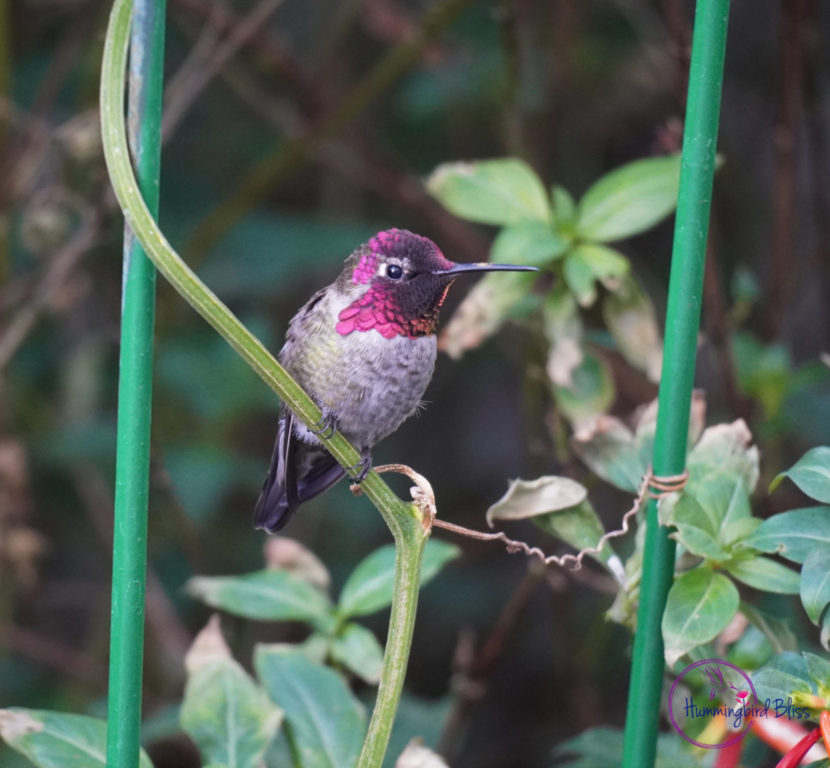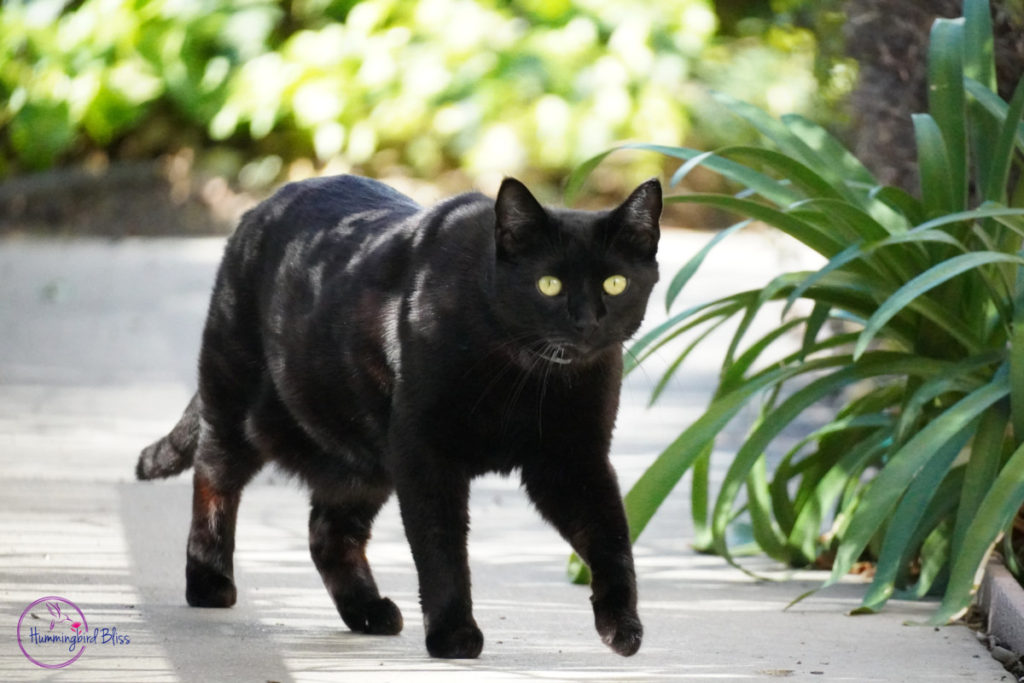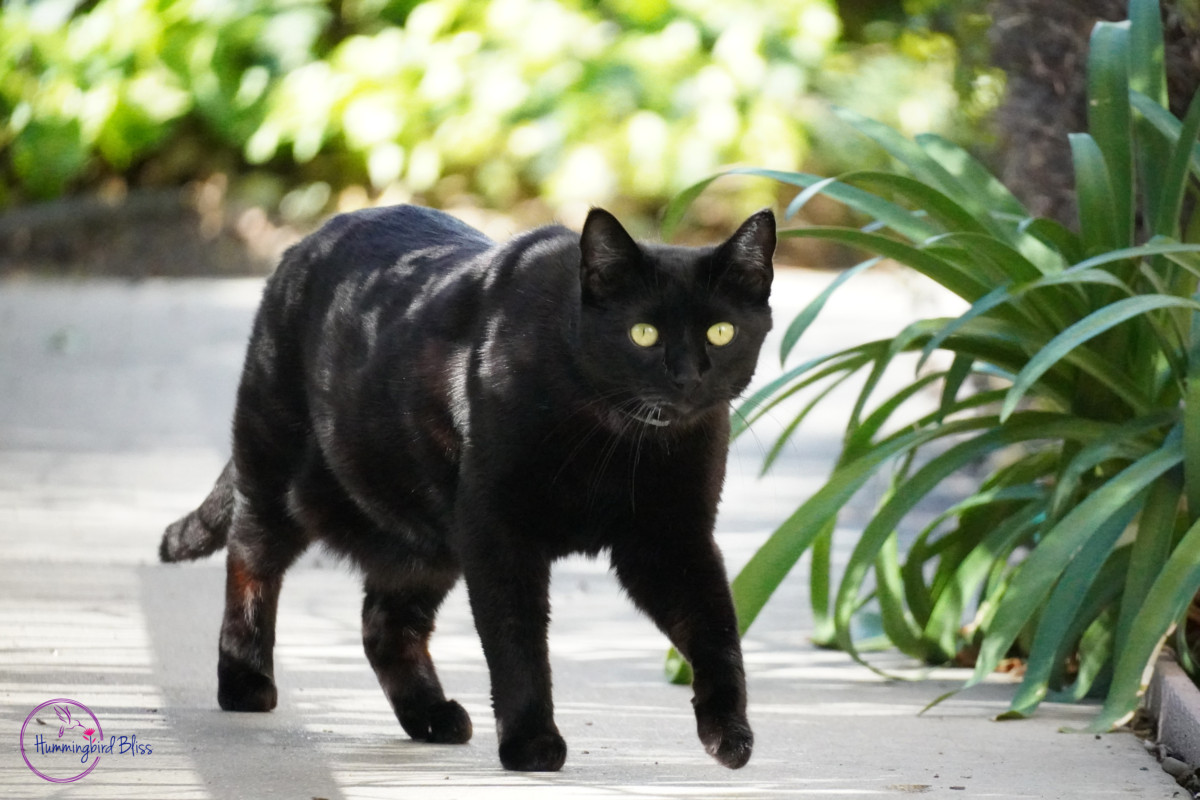This post contains affiliate links.
Cats, in my experience, are a hummingbird’s greatest threat when the hummingbird leaves the wilderness and frequents cities, suburbs, and human inhabited lands adjacent to the forests and wildlands.
Can A Cat Catch A Hummingbird?
All cats, domestic and feral, are very capable of catching and killing a hummingbird whether the hummingbird is stationary or in flight.
Cats can attack from the ground leaping upward, from the side by leaping from a fence or tree branch, or from above via rooftop or other elevated platforms.
Cats are uniquely designed to hunt and kill prey.
Their unwavering focus on the prey comes from their innate driven desire to hunt and kill, not only for food but also for sport. This “sport hunting” is evident in the “capturing” of the prey without the final kill, leaving the prey alive but mortally wounded or in the presentation of a recently killed mouse to the owner’s feet as a testament to “See how great I am!” pride in the trophy.
Cats have powerful rear legs that help propel them quickly to a distance or height that the prey thought was a safe space to occupy.
Their front claws are an excellent and yet sharp hook to snag and hold their prey while the rear claws are used to rip at their bigger prey’s belly.
The lack of a clavicle (collar bone) allows the cat to jump from great heights and land without injury. Their entire front legs are suspended in muscle, with no bony connection to the rest of the skeletal system, allowing them to use their front legs much like a shock absorber on a car.
Cats eyes can see at a frame rate much faster than a human. Humans see videos at 15-20 frames per second without a flicker effect. Cats see at approximately 100 frames per second. This means a cat will detect motion at a speed 5 times faster than a human.
According to the Golden Gate Audubon Society, birds see up to 145 frames per second, making them slightly faster at detecting motion than a cat.
Cats do not need to blink their eyes to keep them lubricated, allowing them to stay constantly focused on their prey.
Cats have a very quick response time from inactive to active movement.
See my article: 10 Common Things That Kill Hummingbirds
Cats can indirectly kill a hummingbird by taking them by surprise and causing the hummingbird to take quick evasive actions to escape the danger.
In a recent experience, I had a disheartening Christmas Eve when one of my best hummingbird friends (Thor) who always greeted me when I arrived home, appreciated fresh homemade nectar and always checked out his turf for unwelcome guests had a sad and tragic departure.
He was strong and handsome and defended his territory passionately.
Unfortunately between heavy winds and a cat who made his way into my small backyard that is fenced in, Thor tried to escape from his favorite perch and ended up running into our slider door and suffered a massive head injury.
I called my local hummingbird rescue for assistance. I thought maybe he was just stunned and needed a few hours to recuperate. Sadly, it was reported he passed away. He will be in our hearts and will forever be missed!

To this day I still try to wrap my brain around what happened. One moment Thor was sitting on his favorite perch and the next moment I heard a thud coming from the sliding glass door. When I looked out to the backyard I did not see anything or anyone in distress. A few minutes later I realized there was an unwanted black cat in my backyard hanging around Thor’s favorite area where he perched. I opened the slider door and yelled and screamed at the cat to scare him away.
Once the trauma was over I came back into my condo and continued my routine as usual. A few minutes later something caught my eye outside near the sliding glass door. I realized my poor hummingbird was upside down, stunned and convulsing right before my very eyes. Then it hit me and I put two and two together realizing that the loud thud that I heard earlier was actually Thor who ran into the sliding glass door.
I have no idea why the cat was on the other side of the small backyard where Thor was not and I do not know why the cat did not have the hummingbird in its mouth. This sad story is an example of a hummingbird caught off guard and by surprise, unfortunately leading to his death.
Do Cats Have Faster Reflexes Than Hummingbirds?
Cats have faster reflexes than some hummingbirds.
A cat’s “Escape” reflex or fight or flight mode from danger is estimated at 40ms but the exact time of “Escape” reflex is somewhere between 0-70ms.
A hummingbird’s “Escape” reflex ranges from 21ms to 53.3ms, species dependent.
According to one ingenious researcher, the reaction time of a cat to a car horn while the cat was on the hood of the car was estimated at 40ms by evaluating a video of the horn-honking event frame by frame, however the actual time could only be evaluated at somewhere between 0 – 70ms.
According to the Journal of Experimental Biology, a hummingbird’s “Escape” reflex time from danger while in the hover position ranged from approximately 21ms to 53.5ms, species dependent. That reflex time would increase a little if the hummingbird’s starting position is perched.
The consensus online is that the Hummingbird’s reflexes are the fastest in the bird kingdom and the Cat has the quickest reflexes in the animal kingdom.
From my own experience, when I was younger, I witnessed my cat catch a hummingbird on my hillside in my backyard. My childhood backyard consisted of a quarter acre hillside dotted with various fruit trees creating a mini orchard that was accessible by a set of long vertical wooden stairs.
This one afternoon I was tagging along behind my mother up the hillside with our cat bringing up the rear. We deviated from the stairs to access the pear tree. While my mother instructed me on various ecological points on the hillside, a hummingbird zoomed past us. I briefly saw motion from the corner of my eye and in an instantaneous micro-moment, the cat lifted it’s right paw and grabbed the hummingbird in flight and placed it in its mouth.
My mother freaked out and was screaming at the cat but he was uninterested in her demands to release the hummingbird. After she chased the cat down the hillside the cat released the hummingbird but it had a puncture wound from the cat’s claw and unfortunately did not survive.
That experience forever changed my perception of sweet innocent pet cats.
To put all this information into perspective, a cat’s or hummingbird’s “Escape” reflex to danger both are less than ½ the time it takes you to blink your eyes.
Will The Presence Of A Cat Keep Hummingbirds Away?
The presence of a cat in the area around hummingbird feeders will not discourage all hummingbirds but it will heighten the “Escape” reflex of those brave enough to feed at a “cat present” feeder. At the first sign of any cat motion the brave hummingbird will be gone.
Hummingbirds are very courageous but also extremely cautious. They observe any new presence, be it cat, human, or any other perceived potential predator, from afar.
They only come closer in small increments of distance and time until they feel less vulnerable to the presence of the perceived potential predator.
Sometimes they become so comfortable with the presence of humans that they will actually feed out of the human’s hand.
See my article: Training a Hummingbird To Be Hand Fed
How Do I Keep Cats Away From My Hummingbird Feeders?
Hang the hummingbird feeder more than 5 feet above the ground and away from lateral or overhead launching platforms a cat might use.
Spray the surrounding area with a liberal dose of cat repellant.
Correct Hummingbird Feeder Placement:
Cats have the ability to jump vertically between 5 and 7 times their body length.
The consensus is that a hummingbird feeder should be at least 5 feet off the ground but 8 feet out of reach of all but the “super cat”.
The Guinness World Record for longest horizontal jump is a cat named Waffle the Warrior who jumped 7 feet on January 30, 2018.
So, keep those hummingbird feeders at least 7 feet away from any potential cat launch platform at the hummingbird feeder’s height, such as a fence or tree limb.
Don’t forget, cats are extremely agile and can attack feeding hummingbirds from above if the feeder is too close to an overhead structure such as a rooftop.
Use Of Cat Repellents:
Cats have an extremely advanced sense of smell. Hummingbirds have no sense of smell so hummingbirds will not even know the area has been sprayed with cat repellent.
There are certain smells that cats do not like such as citrus, vinegar, mint, and cinnamon. Making a DIY cat repellent spray can be as simple as a 1:1 mix of water and vinegar or boiling orange peels for 10-15 minutes.
Green Gobbler Orange Oil Concentrate, a household cleaner, is a popular ready-made spray many claim to be very effective at repelling cats.
Certain plants act as cat repellents also. The most common plant that repels cats is Rosemary. Plant a few Rosemary plants in the area of your hummingbird feeders. Rosemary will stay green year-round and will grow into a nice sized bush. Sprigs of the Rosemary can be harvested and used in cooking also, especially around the holidays.
How Can I Keep My Cat Away From My Hummingbird Feeders?
There is no absolute correct way to keep your own cat away from your hummingbird feeders. The best alternatives are to keep the feeder out of reach, add attention-getting devices to your cat such as a brightly colored collar with a bell attached to identify them as a predator and/or spray homemade cat repellent around the affected surrounding area.
Hummingbird activity is at its peak the first hour after sunrise during the morning and the last hour before dark. Both of these feeding times are critical for a hummingbird to gain the nutrition they need to either jump start their heart in the morning or have enough fuel to last them through the night.
Hummingbirds go into a catatonic state called torpor to diminish their energy needs to survive the night. They awaken hungry and must feed as soon as possible.
See my article: Hummingbird Slumber: The Secret to Conserving Energy at Night
Since these two ideal times are important for survival hummingbird enthusiasts will find
more than usual hummingbird activity around your feeders, therefore keep your own
cat in the house the first hour of daylight and the last hour of daylight.
During the day hummingbirds must eat every 10-15 minutes, however, if their favorite feeder has cats hanging around, they will generally choose to forage in the area’s where nectar flowers exist or on other people’s feeders and not risk the encounter with your cat.
Happy Hummingbird Watching!

Backyard Visitors participates in affiliate programs which compensate us for referring traffic.


